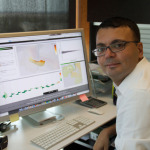In this video, Professors Jean Frechet and David Keyes describe their vision for KAUST’s new Shaheen II Cray XC40 supercomputer. “The initial configuration of Shaheen II will feature nearly 200,000 x86 processor cores. At initial delivery, anticipated in March 2015, Shaheen II will deliver over 5 petaflops of peak performance, with 17.6 petabytes of Sonexion Lustre storage and greater than 790 terabytes of memory.”
Video: KAUST Prepares for Shaheen II Supercomputer
In this video, Mootaz Elnozahy from KAUST discusses the arrival of the Shaheen II supercomputer. Some 25 times more powerful than its predecessor, Shaheen II is a Cray XC40 system with DataWarp burst buffer technology, a Cray Sonexion 2000 storage system, and a Cray Tiered Adaptive Storage (TAS) system.
Video: Preparing the Cray XC40 for Shipment to KAUST
Today’s large-scale compute clusters take a lot of preparation for shipping. “Logistics planning for the KAUST shipment started months in advance, and it took 12 Cray personnel almost five days to prepare and pack the system. The KAUST shipment consisted of 184 boxes, weighed 127 tons, and filled an entire Boeing 747 airplane — plus part of another. Ten semi-trucks were required to transport Shaheen II from Cray’s manufacturing facility in Chippewa Falls, Wisconsin, to the airport in Chicago.”
Job of the Week: Manager of HPC at KAUST
KAUST in Saudi Arabia is seeking a Manager of HPC in our Job of the Week.
KAUST to Acquire Cray XC40
Today Cray announced it has been awarded a contract to provide King Abdullah University of Science and Technology (KAUST) in Saudi Arabia with multiple Cray systems.
NAG Boosts KAUST Petascale Project
At SC14, the Numerical Algorithms Group (NAG) and Red Oak Consulting announced a large supercomputer project with King Abdullah University of Science and Technology (KAUST) in Saudi Arabia.
KAUST Scientists Working to Predict Extreme Weather
KAUST University in Saudi Arabia reports that researchers are using simulation to better understand severe weather events that have caused catastrophic flooding and loss of life in the region.










